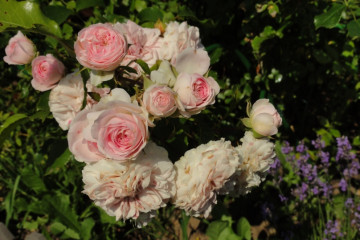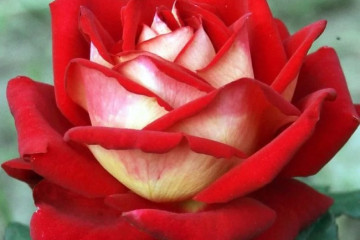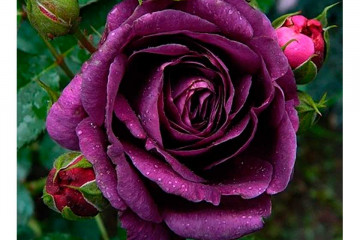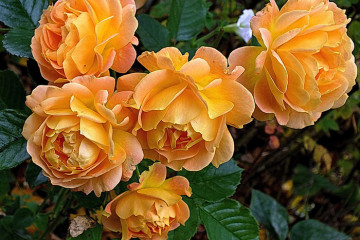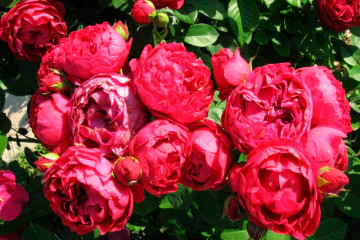Rose Nina Weibull - what kind of floribunda is it?
Content:
- Floribunda rose Nina Weibull
- Brief description, characteristic
- Advantages and disadvantages of the variety
- Use in landscape design
- Growing a flower, how to plant it in open ground
- Plant care
- Blooming rose
- What to do if it does not bloom, possible reasons
- Flower propagation
- Diseases, pests and ways to control them
Rose Nina Weibul belongs to the species of floribund (profusely flowering). The flower is grown for cutting, shoots covered with buds look gorgeous in bouquet compositions. The variety winters well in temperate latitudes, does not require close attention of gardeners.
Floribunda rose Nina Weibull
A cold-resistant, unpretentious variety of a garden rose was obtained in Denmark by crossing a hybrid tea rose with a polyanthus nutmeg. The bush under the shelter can withstand frosts down to -40 ° C. Flowering lasts almost the entire season.
Brief description, characteristic
Rose Nina Weibull forms a loose bush, shoots grow up to 75 cm Leaves are dark green, glossy. Stems with numerous thorns. The flowers are red, bright or dark, do not lose their decorative effect after rain. The diameter of the buds is up to 6 cm. With timely pruning, up to 30 flowers grow on the shoot, they are grouped into inflorescences of 4–5 pieces.
Advantages and disadvantages of the variety
The wide distribution of the floribunda rose Nina Weibul is explained by a number of advantages:
- brightness of color, the bush is noticeable in any corner of the garden;
- flowering duration (in cycles and short intervals);
- frost resistance;
- immunity to fungal diseases;
- unpretentiousness (the rose does not require constant care).
Main disadvantages:
- shoots are covered with large thorns;
- the buds emit little essential oils (with abundant flowering, the aroma from the bush is barely perceptible).
Use in landscape design
Bushes are planted in flower beds singly and in groups. The rose is used to decorate parquet lawns, walkways are framed with floribunda. Designers create bright accents in landscapes with the help of red flowers.
Growing a flower, how to plant it in open ground
In order for the plant to develop well, it must be planted, fed, protected from frost on time.
In what form is the landing
In a permanent place, pre-grown seedlings are placed. They should form a full-fledged root system, and new buds should appear.
What time is the boarding
Although the variety is cold-resistant, it takes time for the bush to mature. Planting dates depend on the region: in any case, the soil should warm up to + 10 ° C. Planting is allowed in autumn, 3-4 weeks before the onset of cold weather. The plant needs to take root before severe frost.
Location selection
For planting, it is better to choose areas with diffused light.In the bright sun, the edges of the petals will dry out faster. The variety tolerates partial shade well if it receives full lighting for 6 hours a day. The bushes are planted on the leeward side so that there are no drafts.
With a high level of groundwater, drainage is done. In low-lying, flooded areas, the rose will not grow. She likes slopes, hills.
How to prepare the soil and flower for planting
Rose Nina needs a neutral soil, with an acidic reaction of the soil, liming is carried out. The earth is carefully dug up, removing the roots of perennial weeds, flavored with humus (0.5 buckets per planting pit measuring 60x60 cm). The finished soil is laid next to the landing site.
The shoots of the seedling are pruned by 1/3, so that the plant quickly adapts to new conditions.
Planting procedure step by step
- drainage is laid at the bottom of the planting pit with a layer of up to 10 cm (broken brick, gravel or expanded clay);
- in the center, a mound is made of prepared soil 10 cm high, the roots of the seedling are spread on it;
- sprinkle the root system with the remaining prepared soil so that the root collar is at a depth of 3 cm;
- the soil is well watered (at least 2 buckets of water per plant), crushed so that there are no voids at the roots;
- carry out mulching with dry peat or humus.
Plant care
The land around the bushes is periodically loosened, cleaned of weeds, and moistened.
Watering rules and humidity
During the rainy season, roses feel at ease, they love moisture. They are watered by sprinkling in the morning, and up to 20 liters are poured onto the bush in dry times. In autumn, watering is reduced, and moderate soil moisture is maintained. In preparation for winter, the plant evaporates moisture slowly.
Top dressing and soil quality
The abundance of flowering rose Nina depends on the nutritional value of the soil. During the period of growth of shoots, the bush needs nitrogen, during flowering - mineral complexes, the dosage is indicated in the instructions.
Pruning and replanting
A transplant with dividing the bush is carried out after a 7-year stay of the rose in one place. Brief description of the trimming procedure:
- in the first year of flowering, the buds are cut off, except for the August ones, 2-3 flowers are left on the shoot;
- in the summer, they periodically prune wilted buds;
- in the fall, old shoots with cracked bark are cut out;
- mature shrubs are pruned annually.

Before the construction of the shelter, the stems of the roses are bent down with a bunch. They do it carefully so as not to break
Features of wintering a flower
- a rose of the Nina variety in areas of risky farming needs shelter. When minus daytime temperatures are established, foliage is removed from the shoots. The soil in the near-trunk circle is mulched with a layer of 10 cm. The shoots are not tightly bent to the ground, fixed, and shelters are made from acrylic canvas on top. For snow protection, spruce branches are laid around the perimeter. In the spring, the temporary shelter is removed, the shoots are straightened.
Blooming rose
The variety is distinguished by long flowering from June to late autumn. This feature is common to all floribunda roses.
A period of activity and rest
The bush releases buds in cycles lasting up to 14 days, then takes a break for 2-3 days, at which time it lays new flower buds.
Care during and after flowering
During the flowering period, the bushes are fed at two-week intervals. In order for new buds to form, old wilting ones are cut off, preventing the seed pods from forming.
What to do if it does not bloom, possible reasons
- the bush is frozen, flower buds died;
- too acidic soil;
- intense lighting;
- pests.
Flower propagation
Roses are propagated in several ways:
- seeds;
- cuttings;
- dividing the bush;
- budding (grafting one variety onto another).
Gardeners often use cuttings to preserve the variety.
When is it produced
Shoots for planting need one-year, they are taken from bushes over 5 years old.
Detailed description
Leaves and buds are removed from the branches. Shoots are cut 20 cm long. Thorns are removed from the lower 1/3 of the cutting. The finished planting material is placed in water for a week. After the roots appear, they are deepened in a prepared planting container.
Diseases, pests and ways to control them
The rose patiently endures the vagaries of the weather, a sharp drop in night and day temperatures, is resistant to powdery mildew, root rot, and spotting. From spider mites, aphids are disposed of using standard methods.
Floribunda looks beautiful in a bouquet and in a flower bed. The buds are not afraid of morning frosts, they retain a pleasant appearance until the first snowfalls. Rose Nina Weibul is a real find for experienced and novice gardeners.





